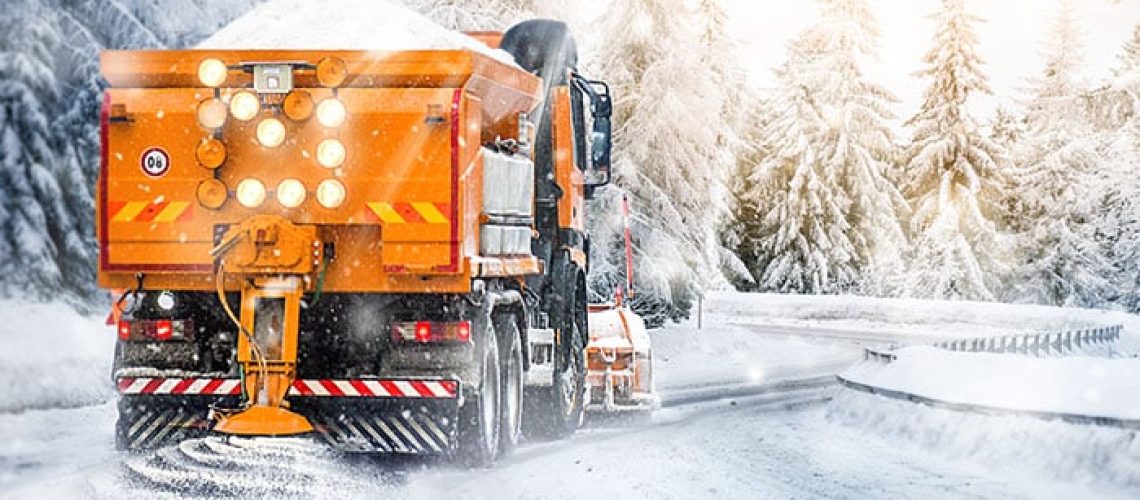Winter brings the joys of snow and hot cocoa but also comes with the challenges of salting the roads and scraping frosty windshields. When it comes to salting the roads, there are multiple options, including sodium chloride, calcium chloride, magnesium chloride, and potassium acetate. There are also some alternative road salt options.
Today’s blog takes a closer look at the types of road salt that are used to keep our roadways safer. Whether you’re a homeowner or a city planner, this blog will provide the knowledge you need to make informed decisions about your de-icing practices.
Sodium Chloride (Rock Salt)
When it comes to de-icing roads, sodium chloride (rock salt) is one of the most common types of salt used.
Rock salt is a naturally occurring mineral mined from underground salt deposits. Rock salt is very effective at melting ice down to about 15 degrees Fahrenheit. However, it isn’t effective at super-low temperatures, so you’ll want another option if it gets colder.
Rock salt is relatively inexpensive and widely available, making it a popular choice for municipalities and transportation departments. Caution is important, though. Rock salt can corrode metal and concrete. Using too much of it can damage the environment by contaminating soil and waterways, and pets and wildlife should be kept away from it.
Sodium chloride is effective and inexpensive but only suitable for some roads.
Calcium Chloride
Calcium chloride is a salt compound composed of calcium and chlorine. It is a white, crystalline solid that is soluble in water and used in various industrial and commercial applications.
Calcium chloride has several advantages. It is used as a de-icing agent to melt snow and ice on roads and sidewalks, making winter driving safer and increasing the hardness of the water. Additionally, calcium chloride is used to preserve food, as it helps to reduce spoilage and extend it’s shelf life.
Magnesium Chloride
Magnesium chloride is a salt compound composed of magnesium and chlorine. It is a colorless or white crystalline solid soluble in water used in various industrial and commercial applications.
One of the primary advantages of magnesium chloride is that it is less corrosive than other types of de-icing salts, such as sodium chloride or calcium chloride. It is also effective at lower temperatures, making it helpful in de-icing sidewalks and driveways. Similarly to rock salt, there can be environmental damage, so it’s essential to use it carefully.
Potassium Acetate
Potassium acetate is a salt compound composed of potassium and acetate ions. It is a white crystalline solid primarily used as a de-icing agent on airport runways and other aviation applications.
One of the primary advantages of potassium acetate is that it is less corrosive than other de-icing salts, such as sodium chloride or calcium chloride, making it a popular choice for use on aircraft surfaces.
Unlike other de-icing agents, potassium acetate is biodegradable and does not harm vegetation or aquatic life. However, it can be more expensive than other de-icing salts and is less effective at lower temperatures, taking longer to melt ice and snow.
Calcium Magnesium Acetate
Calcium magnesium acetate is a salt-free de-icing agent made from calcium carbonate and acetic acid. It is less harmful to the environment than other salts and can be effective at lower temperatures.
Beet Juice
Another option is beet juice, a natural de-icing agent made from sugar beet extract. It is biodegradable, non-corrosive, and does not harm vegetation or aquatic life. However, it can be more expensive than other de-icing agents and may be less effective in extreme weather conditions.
Urea
Urea is a chemical compound commonly used as a fertilizer and a de-icing agent. It is a colorless, odorless solid that dissolves readily in water, making it easy to apply to crops or spread on icy surfaces.
Urea is synthesized commercially using ammonia and carbon dioxide. In addition to its use as a fertilizer and de-icing agent, urea is also used in producing plastics, adhesives, and animal feed.
While urea is generally considered safe, it can have negative environmental impacts if it is over-applied as a fertilizer. Excess urea can cause algal blooms in bodies of water, leading to oxygen depletion and harming aquatic life.
As a de-icing agent, urea is less effective than traditional salts and can be more expensive but is considered a safer and more eco-friendly alternative than the other options mentioned in this blog.
Glycols
Glycols are a class of organic compounds commonly used in aviation applications as a de-icing agent. These compounds have a low freezing point and can remain in a liquid state even in sub-zero temperatures, making them an ideal choice for de-icing airplanes. The most commonly used glycols for de-icing are ethylene glycol and propylene glycol.
While glycols are effective at melting ice and snow, they can adversely affect the environment and human health. Ethylene glycol is toxic and can be harmful if ingested, while propylene glycol is less toxic but can still cause irritation to the skin and eyes.
Additionally, glycols can contribute to water pollution if not properly disposed of. For these reasons, glycols are not typically used as a de-icing agent for roads or sidewalks.
Winter Storm Damage? Call Restoremasters.
As you can see, there are several options for de-icing roadways to make winter driving – and living – safer. But while salting roads and the areas around our homes matters, it isn’t a fix-all solution to ensuring your safety no matter what. Sometimes winter storms wreak havoc, and our homes require repair from water and mold damage.
That’s where we come in. Restoremasters has decades of experience restoring homes from water, mold, smoke, fire, sewage, etc. You can trust us to restore your home to pre-loss condition so you can get back to living life.
Call us at 801.948.2478, or contact us through our website to schedule your appointment.







